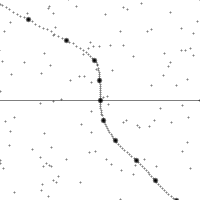伽利略变换
伽利略变换是经典力学中用以在两个只以匀速相对移动的参考系之间变换的方法,属于一种被动态变换。在相对论效应下,伽利略变换在物体以接近光速运动时不成立[1],在电磁系统中也不会成立。[2]
伽利略·伽利莱在解释匀速运动时制定了这一套概念。[3]他用其解释球体滚下斜面这一力学问题,并测量出地球表面引力加速度的数值。
在狭义相对论中,伽利略变换被庞加莱变换所取代;相反,庞加莱变换的经典极限c →∞中的群收缩产生了伽利略变换。
平移
[编辑]
伽利略变换建基于人们加减物体速度的直觉。在其核心,伽利略变换假设时间和空间是绝对的。
这项假设在洛伦兹变换中被舍弃,因此就算在相对论性速度下,洛伦兹变换也是成立的;而伽利略变换则是洛伦兹变换的低速近似值。
以下为伽利略变换的数学表达式,其中和分别为同一个事件在两个坐标系和中的坐标。两个坐标系以相对匀速运行(速度为),运行方向为和,原点在时间时重合。 [4] [5] [6] [7]
最后一条方程式意味着时间是不受观测者的相对运动影响的。
利用线性代数的术语来说,这种变换是个错切,是矩阵对向量进行变换的一个过程。当参考系只沿着x轴移动时,伽利略变换只作用于两个分量:
虽然在伽利略变换中没有必要用到矩阵表达法,但是用了矩阵就可以和狭义相对论中的变换法进行比较。
三种伽利略变换
[编辑]
纵轴为时间,横轴为距离,虚线为观测者在时空中的轨迹。图的下半部是已经发生了的事件,上半部则是未来的事件。图中小点为时空中的事件。
世界线的斜率为观测者的相对速率。注意观测者在加速时所看到的时空会进行错切。
伽利略变换可以唯一写成由时空的旋转、平移和匀速运动复合而成的函数。[8]设x为三维空间中的一点,t为一维时间中的一点。时空当中的任何一点可以表达为有序对(x,t)。速度为v的匀速运动表达为,其中v在R3内。平移表达为,其中a在R3内,b在R内。旋转表达为,其中G : R3 → R3为某正交变换。[8]作为一个李群,伽利略变换的维度为10。[8]
伽利略群的中心扩张
[编辑]这里我们只考虑伽利略群的李代数。结果能够轻易延伸到李群。L的李代数由H、Pi、Ci和Lij张成(反对称张量),并能够受交换子的作用,其中
H为时间平移的生成元(哈密顿算符),Pi为平移的生成元(动量算符),Ci为伽利略变换的生成元,而Lij为旋转的生成元(角动量算符)。
现在我们可以对H'、P'i、C'i、L'ij(反对称张量)、M所张成的李群进行中心扩张,使得M与一切都可交换(位于中心,“中心扩张”因此得名):
参见
[编辑]备注
[编辑]- ^ 伽利略變換. [2021-06-26]. (原始内容存档于2021-06-28).
- ^ Arthur Beiser; Kok Wai Cheah. Concepts of modern physics. McGraw-Hill. 2015: 第6页. ISBN 9789814595261.
- ^ Galileo 1638 Discorsi e Dimostrazioni Matematiche, intorno á due nuoue scienze 191 - 196, published by Lowys Elzevir (Louis Elsevier), Leiden, or Two New Sciences, English translation by Henry Crew and Alfonso de Salvio 1914, reprinted on pages 515-520 of On the Shoulders of Giants: The Great Works of Physics and Astronomy. Stephen Hawking, ed. 2002 ISBN 978-0-7624-1348-5
- ^ Mould, Richard A., Basic relativity, Springer-Verla, 2002, ISBN 0-387-95210-1, Chapter 2 §2.6, p. 42 (页面存档备份,存于互联网档案馆)
- ^ Lerner, Lawrence S., Physics for Scientists and Engineers, Volume 2, Jones and Bertlett Publishers, Inc, 1996, ISBN 0-7637-0460-1, Chapter 38 §38.2, p. 1046,1047 (页面存档备份,存于互联网档案馆)
- ^ Serway, Raymond A.; Jewett, John W., Principles of Physics: A Calculus-based Text, Fourth Edition, Brooks/Cole - Thomson Learning, 2006, ISBN 0-534-49143-X, Chapter 9 §9.1, p. 261 (页面存档备份,存于互联网档案馆)
- ^ Hoffmann, Banesh, Relativity and Its Roots, Scientific American Books, 1983, ISBN 0-486-40676-8, Chapter 5, p. 83 (页面存档备份,存于互联网档案馆)
- ^ 8.0 8.1 8.2 Arnold, V. I. Mathematical Methods of Classical Mechanics 2. Springer-Verlag. 1989: 6 [2013-01-30]. ISBN 0-387-96890-3. (原始内容存档于2013-03-12).
| ||||||||||||||||||||||||||||||||||||||||||||||||||||||||||||||||||||
Text is available under the CC BY-SA 4.0 license; additional terms may apply.
Images, videos and audio are available under their respective licenses.
















![{\displaystyle [H,P_{i}]=0\,\!}](https://wikimedia.org/api/rest_v1/media/math/render/svg/2de6f07c2a65a586dbaebb514e8158741c69ac1b)
![{\displaystyle [P_{i},P_{j}]=0\,\!}](https://wikimedia.org/api/rest_v1/media/math/render/svg/e108d10a8f16af47969cb6685fd1a5c65ae3472d)
![{\displaystyle [L_{ij},H]=0\,\!}](https://wikimedia.org/api/rest_v1/media/math/render/svg/8a87d6b8aa578fa6b9a734b6b7388625d67e413e)
![{\displaystyle [C_{i},C_{j}]=0\,\!}](https://wikimedia.org/api/rest_v1/media/math/render/svg/417c196a6e1a5dd592ffb2e070716e9aa3300bdf)
![{\displaystyle [L_{ij},L_{kl}]=i[\delta _{ik}L_{jl}-\delta _{il}L_{jk}-\delta _{jk}L_{il}+\delta _{jl}L_{ik}]\,\!}](https://wikimedia.org/api/rest_v1/media/math/render/svg/5fe9fe77b6c2b95eb1709ab3f9c1efc5214869ca)
![{\displaystyle [L_{ij},P_{k}]=i[\delta _{ik}P_{j}-\delta _{jk}P_{i}]\,\!}](https://wikimedia.org/api/rest_v1/media/math/render/svg/ee2890cbf3a1216d04af637c2a13b0d24554fd37)
![{\displaystyle [L_{ij},C_{k}]=i[\delta _{ik}C_{j}-\delta _{jk}C_{i}]\,\!}](https://wikimedia.org/api/rest_v1/media/math/render/svg/402e64fc45286804abdf22f34271fcea350bbcfd)
![{\displaystyle [C_{i},H]=iP_{i}\,\!}](https://wikimedia.org/api/rest_v1/media/math/render/svg/ca5972e950d30691dba2fafc2e58977300b6ad69)
![{\displaystyle [C_{i},P_{j}]=0\,\!.}](https://wikimedia.org/api/rest_v1/media/math/render/svg/d88d63ff279a360c63ee2678d1a733f8a15da30c)
![{\displaystyle [H',P'_{i}]=0\,\!}](https://wikimedia.org/api/rest_v1/media/math/render/svg/c5de574832089c79e6f579c52ef4de1f1f950c13)
![{\displaystyle [P'_{i},P'_{j}]=0\,\!}](https://wikimedia.org/api/rest_v1/media/math/render/svg/8e56cbe7fc5ad8aaa4b5e99bd208e961edcbb242)
![{\displaystyle [L'_{ij},H']=0\,\!}](https://wikimedia.org/api/rest_v1/media/math/render/svg/334b98de717fad3a286c171163b52e65222e72a5)
![{\displaystyle [C'_{i},C'_{j}]=0\,\!}](https://wikimedia.org/api/rest_v1/media/math/render/svg/7c93f26d28dda58f1c60e3938f66753530cd0fec)
![{\displaystyle [L'_{ij},L'_{kl}]=i[\delta _{ik}L'_{jl}-\delta _{il}L'_{jk}-\delta _{jk}L'_{il}+\delta _{jl}L'_{ik}]\,\!}](https://wikimedia.org/api/rest_v1/media/math/render/svg/627522438a338d0623fe653177fbf778892aa7d3)
![{\displaystyle [L'_{ij},P'_{k}]=i[\delta _{ik}P'_{j}-\delta _{jk}P'_{i}]\,\!}](https://wikimedia.org/api/rest_v1/media/math/render/svg/bc33032edd56c7309ae548c711c86071e157dc0b)
![{\displaystyle [L'_{ij},C'_{k}]=i[\delta _{ik}C'_{j}-\delta _{jk}C'_{i}]\,\!}](https://wikimedia.org/api/rest_v1/media/math/render/svg/8f774a5b5348649053a05ecb9349301f2f659c5e)
![{\displaystyle [C'_{i},H']=iP'_{i}\,\!}](https://wikimedia.org/api/rest_v1/media/math/render/svg/eaa99e5eac46bb60b94276b49313baea2e8dabc3)
![{\displaystyle [C'_{i},P'_{j}]=iM\delta _{ij}\,\!}](https://wikimedia.org/api/rest_v1/media/math/render/svg/5bf3e98524cf8590d40c83fa67451363db4fe707)

